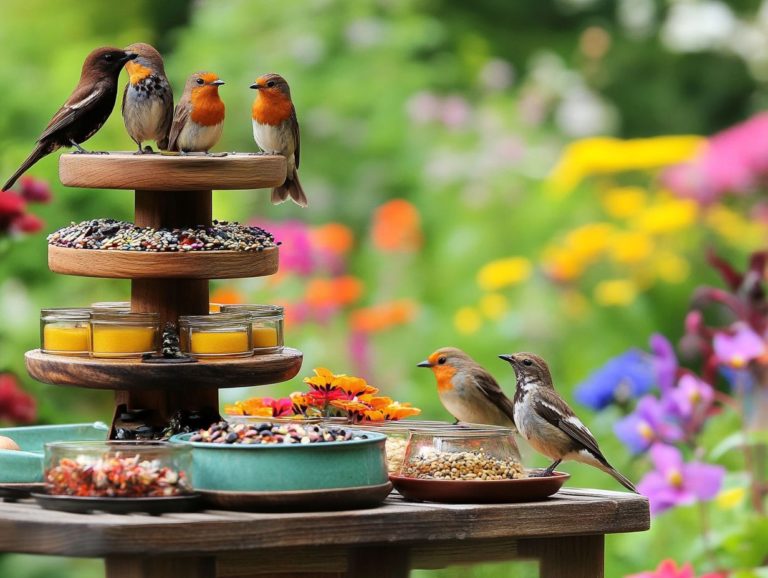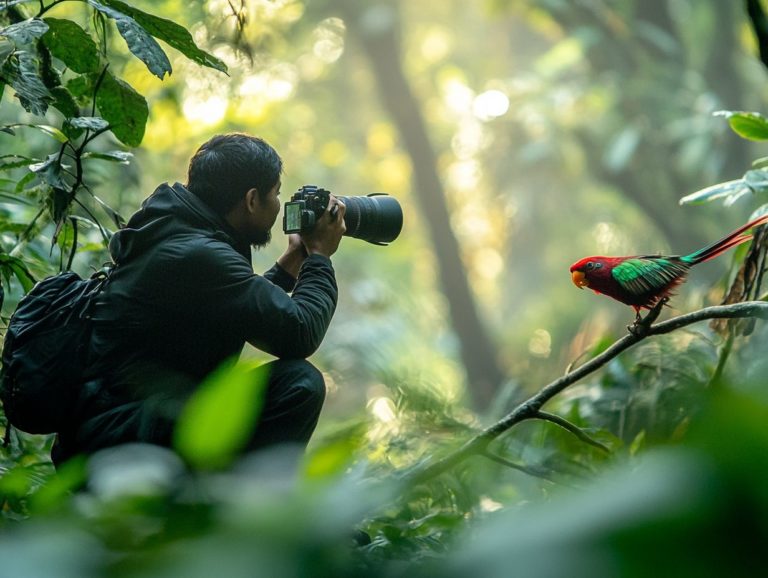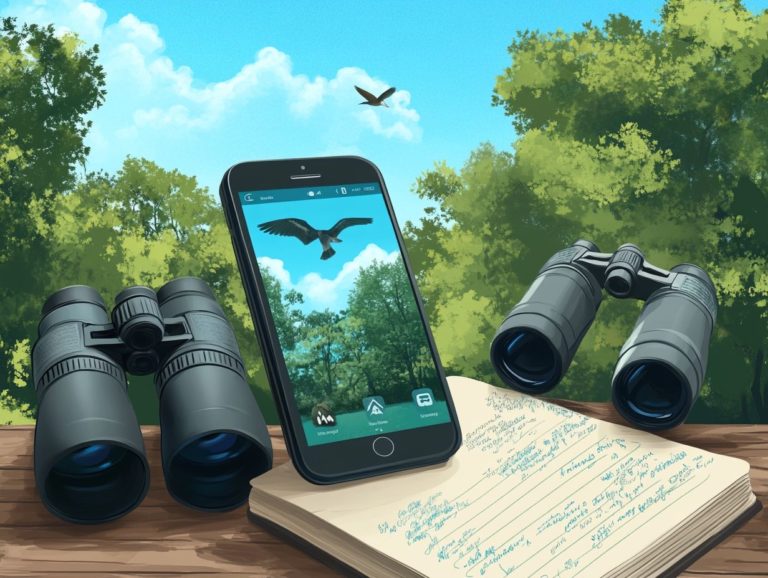How to Participate in Bird Surveys?
Bird surveys serve as essential instruments for understanding bird populations and their habitats. By participating in these surveys, you can play a vital role in exciting conservation efforts and scientific research.
This guide explores the numerous benefits of joining a bird survey, outlines effective preparation strategies, and walks you through the process.
You ll also discover how to interpret and report your findings, along with best practices that ensure your surveys remain accurate and ethical. Whether you’re a seasoned birdwatcher or just starting out, there s invaluable insight awaiting you here.
Contents
- Key Takeaways:
- Why Participate in Bird Surveys?
- How to Prepare for a Bird Survey
- Conducting a Bird Survey
- Interpreting and Reporting Results
- Best Practices for Bird Surveys
- Frequently Asked Questions
- What is a bird survey and why should I participate?
- How do I find bird surveys to participate in?
- Do I need any special equipment to participate in bird surveys?
- I’m new to bird surveys. What can I do?
- What should I do if I encounter a rare or endangered bird during a survey?
- Can I participate in bird surveys if I am unable to physically go to the survey location?
Key Takeaways:

- Participating in bird surveys helps contribute to conservation efforts and scientific research.
- Proper preparation and equipment, as well as following a step-by-step process, are essential for conducting accurate and ethical bird surveys.
- Effective data collection and analysis, along with following best practices, are crucial for interpreting and reporting results from bird surveys.
What are Bird Surveys?
Bird surveys offer a chance for organized counting and observations of bird species within a designated area. They play a crucial role in enhancing our understanding of bird populations and their overall health.
These surveys use various methods, including point counts, transect surveys, nest monitoring, and species-specific assessments. This variety of methods helps you gather important data about how many birds are present, where they are, and what they do.
By immersing yourself in these activities, you cultivate a deeper connection with the natural world and empower yourself to contribute to scientific knowledge. Organizations like the National Audubon Society and BirdLife International rely on this rich repository of information to formulate effective conservation strategies and advocate for impactful policy changes.
When you participate in projects like the Birds in Backyards program, you become an active participant in preserving biodiversity, ensuring that future generations can enjoy the avian wonders of our planet.
Why Participate in Bird Surveys?
Participating in bird surveys presents a wealth of benefits, particularly in fostering a sense of community among bird watchers of all ages while contributing to vital conservation efforts.
Engaging in initiatives like the Great Backyard Bird Count sharpens your birding skills and aids in collecting essential data that tracks bird populations and their overall health.
By getting involved, you become an integral part of a broader citizen science project, where everyday people help collect scientific data, shaping conservation narratives and strategies across diverse regions.
Benefits for Conservation and Science
The benefits of bird surveys extend beyond mere enjoyment; they are crucial for conservation and enhancing our scientific understanding of bird populations. When you participate, the data you collect as a citizen scientist becomes instrumental for researchers tracking bird health, assessing species diversity, and monitoring changes in bird populations over time.
This invaluable information is key to developing effective strategies for wildlife research and conservation efforts.
By participating, you deepen your appreciation for avian species while contributing significantly to gathering critical metrics that reveal habitat preferences and migration patterns. Scientists depend on your efforts to spot declining species and identify areas needing protection, ensuring a focused approach to conservation.
A thorough analysis of survey results enables the evaluation of environmental changes, such as climate shifts and habitat loss. This further emphasizes the necessity of coordinated actions to maintain healthy ecosystems. Therefore, every individual participating in these bird counting initiatives becomes an essential player in preserving avian diversity, fostering a richer connection between the community and the natural world.
Join us now and become part of a community dedicated to preserving our feathered friends!
How to Prepare for a Bird Survey

Get ready to immerse yourself in the exciting world of bird surveys and make a real difference! Preparing for a bird survey requires a clear understanding of the necessary steps and the essential equipment needed to effectively monitor the avian life in your area.
Whether you’re gearing up to participate in the Great Backyard Bird Count or any other survey method, it s crucial to familiarize yourself with the tools that will enhance your experience think binoculars, field guides, and educational kits.
Being well-prepared not only enriches your birding adventure but also gives you the power to contribute accurate data that aids in tracking bird populations and assessing their health.
Essential Equipment and Skills
Quality binoculars and field guides are crucial for birding. They allow you to spot various species and report your sightings accurately. A solid understanding of bird identification and observation skills will significantly elevate your experience during a bird survey.
These tools not only help you spot various bird species but also improve your ability to report sightings accurately online.
Investing in a pair of high-powered binoculars lets you see birds clearly from a distance, making it easier to pick up on small details like plumage patterns or behaviors. Pairing this with a comprehensive field guide offers critical insights into species’ habitats, calls, and migratory patterns, enriching your survey experience.
Cultivating specific skills, such as patience and active listening, will deepen your engagement with the environment. Regular practice in diverse habitats will also bolster your confidence in documentation, ultimately enhancing your success in tracking and reporting the diverse avian life around you.
Conducting a Bird Survey
Conducting a bird survey demands an organized method to guarantee accurate monitoring, particularly when engaging in community science initiatives such as eBird or the Great Backyard Bird Count.
By following established survey methods, you not only gather reliable data on bird populations but also contribute valuable observations to the online community. Adhering to these best practices gives you the power to play a crucial role in tracking the health of avian species and their habitats.
Step-by-Step Process
The step-by-step process for conducting a bird survey encompasses planning, preparation, observation, and data collection, allowing you to effectively monitor bird health and populations.
-
First, it s crucial to develop a comprehensive survey protocol that clearly outlines the specific methods and tools you ll use for data collection, including checklists and GPS devices, which help you track your location easily.
-
You should also familiarize yourself with the relevant environmental conditions that might influence bird visibility and behavior, such as weather patterns or the time of day.
-
During the observation phase, careful note-taking is essential; documenting everything from the number of individual birds to their interactions and preferred habitats will significantly enhance the quality of your survey results.
-
Finally, ensure your data is systematically organized and analyzed to spot trends in bird populations and health, contributing valuable insights to conservation efforts.
Interpreting and Reporting Results
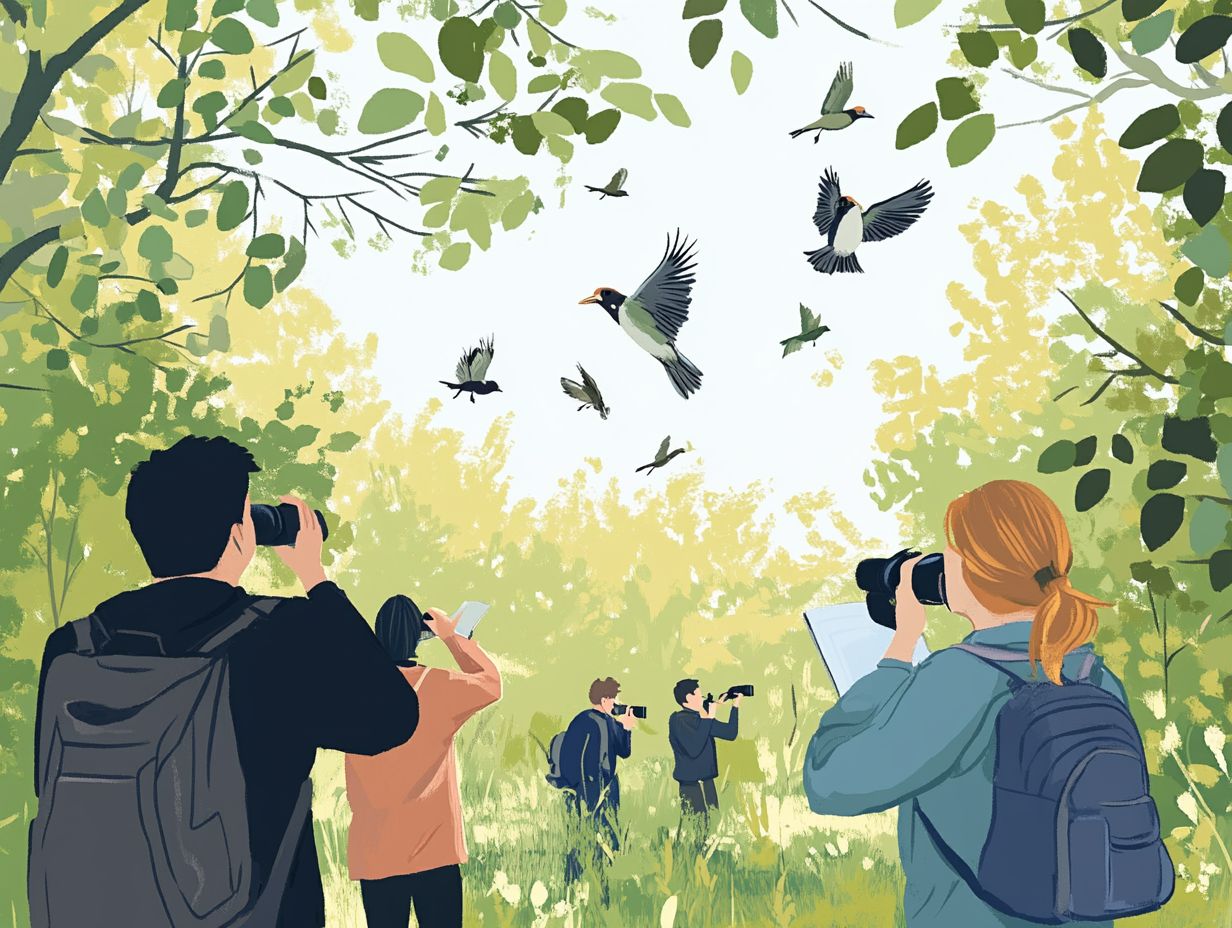
Interpreting and reporting the results of a bird survey is an essential step in enhancing your contribution to the scientific community and preserving a comprehensive archive of bird populations. Once you ve gathered data on bird observations online, it s imperative to analyze your findings.
This analysis allows you to assess the health of various bird species and recognize trends over time. Such long-term data is invaluable for wildlife conservation and serves as a foundation for future research on bird populations.
Ready to get started on your bird survey adventure? Participate in bird surveys and share your findings with friends!
Effective Data Collection and Analysis
Effective data collection and analysis are crucial for ensuring your bird surveys yield valuable insights into bird populations and their overall health. By adhering to standardized survey methods, you can gather precise observations that facilitate meaningful analysis.
This is essential for monitoring birds. It enables you to draw significant conclusions about species diversity and population trends.
To optimize your data collection, employ a combination of point count surveys, transect walks, and visual identification techniques. Each method offers unique benefits that allow you to capture a comprehensive snapshot of avian communities across various habitats.
Using tools like digital field guides and mobile apps makes data entry easier and more accurate. Analyzing the collected data often involves using statistical software and special software for mapping data to uncover patterns in bird distributions and track changes over time.
Follow these best practices to make a real difference in bird conservation today!
Best Practices for Bird Surveys
Implementing best practices for bird surveys is essential for conducting effective and ethical assessments. This significantly contributes to conservation efforts and the accurate monitoring of bird populations.
Respect nesting seasons, minimize disturbances to wildlife, and use ethical survey methods to ensure reliable data collection.
By following these guidelines, you can elevate the quality of your surveys and make a meaningful impact on conservation initiatives.
Tips for Accurate and Ethical Surveys
To ensure your bird surveys are both accurate and ethical, it s vital to follow established guidelines. These promote responsible birding and mitigate negative impacts on bird populations.
Familiarize yourself with survey methods, respect wildlife, and adhere to the principles of community science projects, where local people help scientists gather data.
Using appropriate tools, such as field guides and technology, enhances your identification skills while minimizing disturbances. Visit habitats during optimal times to reduce stress on the birds and ensure you interfere as little as possible with their natural behavior.
Engaging with local birding communities provides valuable insights and fosters a collective commitment to ethical practices. By keeping detailed records of your sightings, you support your growth as an observer and contribute to broader conservation efforts. This offers crucial data that researchers and decision-makers can leverage.
Frequently Asked Questions
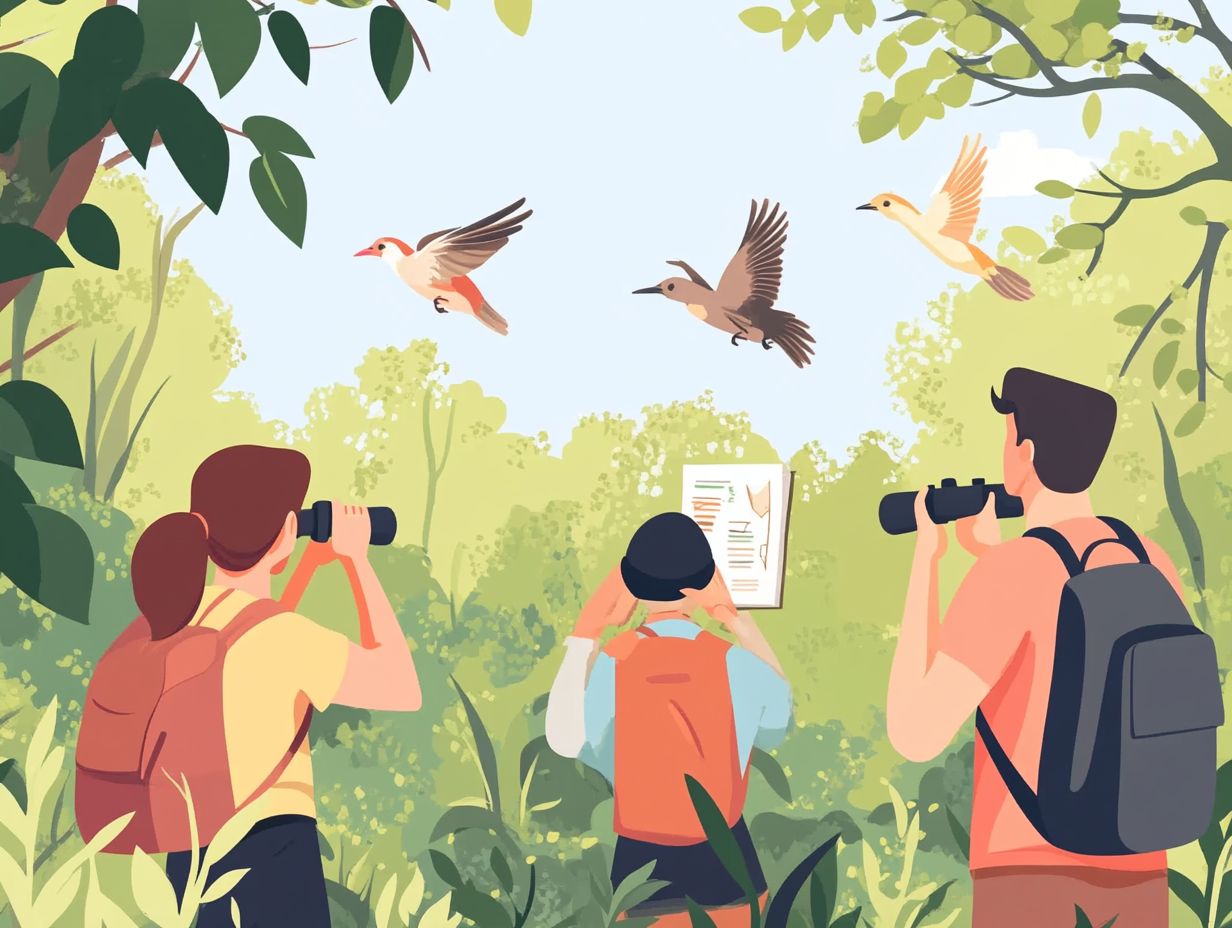
What is a bird survey and why should I participate?
A bird survey is a method of collecting data on the bird population in a specific area. By participating, you help scientists and conservationists track bird populations and make informed decisions about their conservation.
How do I find bird surveys to participate in?
Many organizations conduct bird surveys, such as Audubon Society, Cornell Lab of Ornithology, and local birding clubs. You can also check online for upcoming surveys in your area.
Do I need any special equipment to participate in bird surveys?
No, all you need is a pair of binoculars, a field guide for bird identification, and a way to record your observations, such as a notebook or a smartphone app.
I’m new to bird surveys. What can I do?
Don t worry! Many bird surveys welcome beginners and have experienced volunteers to guide you. You can also attend workshops or training sessions organized by the survey’s conducting organization.
What should I do if I encounter a rare or endangered bird during a survey?
If you come across a rare or endangered bird, do not disturb it or its habitat. Record your observation and report it to the organization conducting the survey or to the appropriate authorities.
Can I participate in bird surveys if I am unable to physically go to the survey location?
Absolutely! You can still contribute to bird surveys from the comfort of your home.
Join community science projects by reporting your bird observations from your backyard. You can also help organizations conducting surveys through donations or volunteer work.

